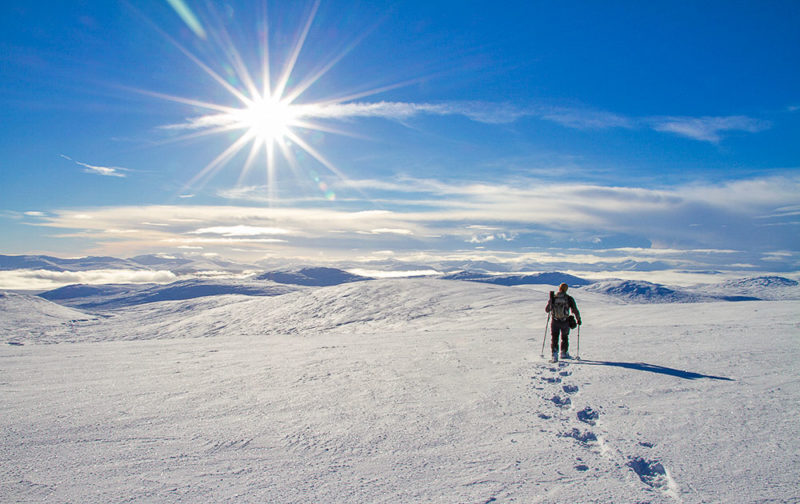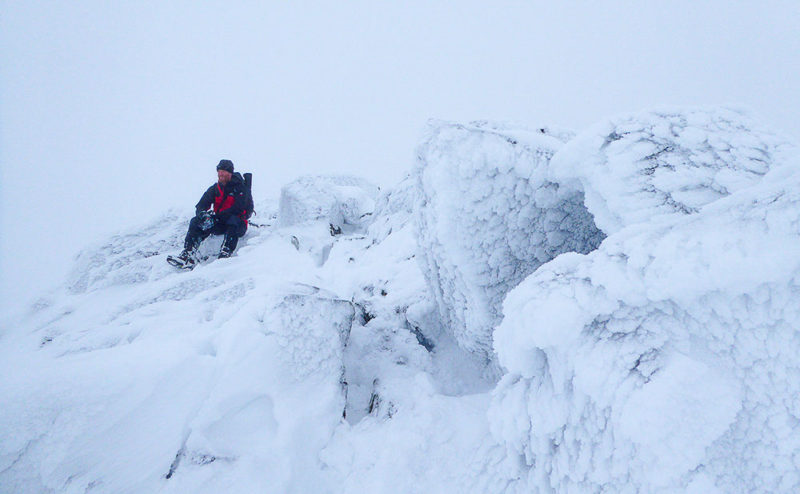
Not because I carry any particular torch for week after week of mild windy mush, of course. I have my limits like everyone else but I think many of us would agree there’s definitely something cosy and familiar about hunkering down in refuge from foul Scottish weather. It’s reassuringly familiar, that snug feeling of being indoors when it’s filthy outside. But I think we would also all agree that it’s only nice so long as it’s not ALL that you experience ALL of the time, because however cosy such conditions may be, we all quickly get to the point where we’ve had enough. But one day into this unsettled spell I’m not close to that point just yet, which means that the strange goodwill I’m feeling towards the foulness raging outside my window speaks volumes about the kind of weather we’ve experienced this autumn. Perhaps absence really does make the heart grow fonder.
Sunniest November on record
Week after week, whether it was on modest wee lumps in West Lothian, the Tarmachan Ridge or the sprawling plateaux at Drumochter, I found myself looking across fog-filled straths and glens, with waterproofs stashed firmly in my rucksack and a beaming sun-kissed smile on my face. In stark contrast to recent years it has been dry and it has been sunny, and as a result I think many of us have realised what we’ve been missing.

A little piece of snowshoe heaven under a blazing sun – Sgairneach Mhòr, Drumochter
In October Scotland received just 37% of the long term average rainfall for that month, and November followed suit at around 68% of expected rainfall. In the sunshine stakes we received 134% of the sunshine we would normally expect to receive in October, making it the third sunniest October since that dataset began in 1929, although for northern Scotland it was the sunniest October on record! November fared even better for blue skies with the country racking up 144% of the average monthly sunshine but again, the north fared even better still at 153% of the average. All in all it was Scotland’s sunniest November since records began. It made the news headlines, but did it feel particularly sunny?
Before we get carried away I should probably point out that none of this means Scotland blazed like the Costa del Sol during autumn with parched landscapes and wall-to-wall sunshine every day. When we describe sunshine as being above the Scottish average…..well, as you can imagine it’s hardly starting from a particularly high baseline in the first place.
Day length shortens as we move through the month of course, as it does the farther north you go, but generally speaking November starts with around nine hours of daylight per day and ends with around seven. For Perth, a city located fairly centrally in Scotland that amounts to about 245 hours of daylight across the whole month. Set against that possible total, the 65.8 hours of sunshine we received in November this year seems pretty rubbish doesn’t it? It represents little more than a quarter of every day! To compare it with our near neighbour, England’s long term November average for sunshine is pretty much the same as our recent record breaking month, at around 65 hours.

Fog-bound on Schiehallion. You still get those pesky days in an ‘above average’ month for sunshine.
Similarly when an autumn month is said to have been drier than average, we need to bear in mind just how wet the Scottish average is in the first place. November averages out at around 170mm nationwide, so while the 113.1mm we experienced this year made it our driest November for 24 years, sat next to the English November average of just under 90mm we still experience a monsoon by comparison. But you probably don’t need dry statistics to tell you that. If you’re anything like me you can tell just by looking at your car that there must have been wet stuff outside. My car is filthy!
Never the less, because we are relatively sun-starved and sodden at the best of times we certainly notice it when we deviate from the norm. Others probably have different perceptions but, for me, given that June, July, August and September were all wetter than usual in Scotland and, with the exception of August they were all much duller than normal too, the dry, sunny weather we’ve enjoyed this autumn stood out a mile.
Happily its tail end has also been cold. November was a significant 1.6C below the long term average with colder nights and more frosts than normal. And I dare say we all felt it keenly because cold months are something we’re not accustomed to in these ‘modern’ autumns. Taking the meteorological autumn (the months of September, October and November), only 8 of the last 30 autumn months have been colder than average in Scotland, and of the last ten Novembers only 2010 was colder. That deficit is regrettable because it means we miss out on beautiful still days dawning cold with frost, ice lingering in the glens all afternoon with the temperature not exceeding zero, and a tangible absence of biting insects. In short, perfect hillwalking weather.

Fog-filled Central Belt seen from Cockleroy Hill, West Lothian.
Much of November was murky down below but gorgeous up above.
This autumn has therefore been heavenly, not least because it yielded my first snowy walks of the season. And not just any snowy walks. I was actually able to use my snowshoes at what is perhaps the earliest point in any year I can remember. Typically you’d expect Scottish snow to fall in a storm and then be blasted across the hillside to accumulate on ridges and in hollows, which isn’t great for snowshoeing because you’re continually climbing in and out of your gear every few hundred metres as you encounter ice, bare rock and deep drifts in quick succession. But the snow that fell in November did so in a uniform fashion across the hills, giving a perfect deep powdery surface for snowshoeing.
Combined with the blue skies and sunshine, Scotland therefore reached that exquisite hillwalking nirvana of continental-style conditions. On more than one occasion I found myself sat 1000m or so up a hillside in the snow, wearing just one fairly thin long-sleeved walking top, sipping tea and nibbling cake, feeling like I was sat on the sun-kissed terrace of an alpine ski resort. And every time I sat in such a place, surrounded by snow that was deep and even, I had the same questions on my mind:
Where was the spindrift?
Where was the windslab?
Where was the frostnip?
Where were the trampolines spinning down suburban streets?
Where were the waves crashing over the railway line at Saltcoats?
Where were the bedraggled BBC reporters on the quay at Stornoway?
Where were the Amber weather warnings?
Where was………the wind?
Benign’s the word
We’ve spent the last few years being pummelled into submission by weather of the windy variety. By this time last year the autumn had already brought us Storms Abigail, Barney, Clodagh and Desmond. Four batterings in the space of 24 days, the last of which caused substantial flood damage to Hawick and Dumfries. So far this season there has only been one storm significant enough to be named, and though it sported a good Scottish name it completely ignored the north and instead barrelled up the English Channel. Angus brought 80mph winds to the English coast but up here in Scotland it barely caused a flutter.
I know my memory isn’t what it used to be but I have no recollection of wind whatsoever in Fife, West Lothian or Perthshire. Am I remembering wrongly or was it really not windy where I living, working and playing? At home, sleep has certainly come easier to me this autumn than last as I’ve not had the sounds of an express train whizzing past the house at night. At work I’ve not had to contend with almost daily inspections of our path network to see whether it’s been blocked by windblown trees. And at play I’ve not had to pick ice out of my beard.

Sunset and alpenglow on Stob Binnein. As benign a hillwalking day as you could wish for.
I suspect I am being selective in my recollections because, of course, it can’t have been utterly calm for weeks on end. And indeed it wasn’t. The Met Office overviews for October and November do mention breezy days nationwide and gales in the northwest, but the persistence of the pattern is what lingers in the memory rather than the odd blips to the contrary here and there. And my enduring memory of the autumn can therefore be summed up in just one word. Benign.
125 mile visibility
The culprit for the calm weather was unusually stubborn high pressure sat on or close to us for much of autumn, keeping the Atlantic at bay and giving some relief from those westerlies we’re most accustomed to. Instead the wind direction, when there was one of course, veered northerly or easterly, both of which are fantastic for air clarity at this time of year. Coupled with the inversion conditions created by the high pressure, visibility up high has been astonishing in its range and definition.
Last week I saw a photo [see this forum post] where someone had snapped the view south from Ben Macdui, at 1309m (4295ft) Scotland’s second highest hill behind Ben Nevis. They had managed to catch a glimpse of The Cheviot way off on the horizon, a whopping 125 miles to the south in Northumberland. To put that into context it’s the equivalent of being able to see Mallaig from Edinburgh. It was magnified of course and still very faint, but it was undoubtedly there to be seen, and such a line of sight is very rare.

Was 2016 the most beautiful autumn in living memory? Quite possibly if this scene at Aros Park on Mull was repeated nationwide.
The calm weather also undoubtedly played a major part in producing the dazzling autumnal display that Scotland put on in 2016. Temperatures and rainfall levels over the summer and autumn were already expected to be conducive to particularly vivid displays of autumn colours this year, but they’d not have counted for much if the leaves had been blasted off the trees by 80mph winds in October. Instead, in the absence of anything approaching a gale, the leaves remained on the trees well into November, allowing them to redden and brown still further. The results were staggering and social media was awash with Scots saying they’d couldn’t remember seeing a more beautiful autumn.
However… back in the here and now
Sunny, dry, cold and calm are but a memory, the pendulum having well and truly swung in the other direction since then and normal service appearing to have been resumed. Bridge restrictions and ferry cancellations are a regular feature on travel reports, the frost is gone, it’s a bonkers 16C here in Fife and local December temperature records are tumbling across the country. It is a few days on from when I wrote the opening paragraph of this article and I can still hear the surging roar of approaching gusts of wind.. The tree branches are still whooshing. The wheelie bins are still clunking. The double glazing is still whistling and the diesel engine is still running.
Oh it’s all depressingly familiar isn’t it?
